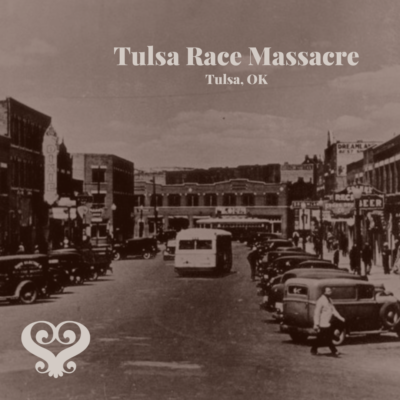On the corner of Greenwood Avenue and Archer Street there’s a mural on the side of a building. Nearby is Lefty’s on Greenwood, a restaurant with a mainly white lunch crowd that receives 4.3 stars and 703 reviews. Those interested in moving to this Oklahoma city could live in Green Arch Apartments which come with amenities like a yoga studio and list proximity to Whole Foods as a perk.
102 years ago, in the heart of what W.E.B. DuBois coined “Negro Wall Street,” stood a thriving community. Pharmacies, dry cleaners, and beauty shops— all Black-owned and operated. What a sight it must have been to see a thriving Black community helping one another and conducting such robust commerce. The residents of Greenwood at this time were their ancestors’ wildest dreams. Tragically, the dream would soon become a nightmare.
On May 30th, 1921, 19-year-old Black shoe-shiner Dick Rowland walked into an elevator with local white teenager, Sarah Page. When the doors opened, Page was screaming and Rowland ran. Page claimed Rowland assaulted her and he maintained it was an accident. Rumors swirled and the next day, Rowland was arrested and a lynching seemed imminent. Black war veterans gathered at the courthouse in defense. A white mob also formed. Words were exchanged and in the commotion, gunshots fired. The Massacre in Tulsa had begun.
Resentment from white people toward the rise in wealth and confidence of Black citizens grew. Returning from WWI, Black soldiers were not accepting systematic oppression as a reward for serving their country. This led to the “Red Summer of 1919.” Twenty-five racial conflicts raged across the country taking hundreds of Black lives with it. Senior Manager at the NMAAHC, John W. Franklin said, “They came home to parades on Fifth Ave, but they were lynched in their uniforms across the country during the summer of 1919.”
Over the next two days as many as 5000 white men, armed and deputized by police, stormed the Greenwood neighborhood to reestablish the racial hierarchy in Tulsa. They looted homes, murdered people in cold blood, and systematically burned buildings. Survivors of the massacre recall witnessing planes dropping bombs filled with turpentine or coal oil. This marked the first time U.S. citizens were attacked from the air. It’s estimated that hundreds of Black people were killed. Thousands were left homeless.
This past weekend, Sankofa Impact attended the Black Wall Streets event hosted by Africatown Community Land Trust (ACLT). The event honored the 102nd anniversary of the Tulsa Race Massacre, while also celebrating Black business and entrepreneurship in the Puget Sound region. While we fight for reparations, we intentionally celebrate Black resilience.

